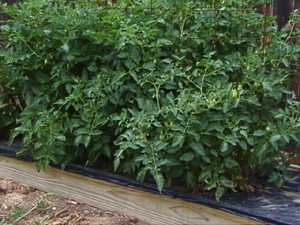By Brent McGhie, Butte County Master Gardener, May 22, 2015
As the drought continues and the need to conserve water increases, some of us are eliminating our vegetable gardens this year. However, if vegetable gardening is a necessity for you, it is possible to significantly reduce water use in the garden.
Before planting a single seed, a good first step in vegetable gardening is to amend the soil with compost. Compost adds organic material to the soil, improving the soil's water environment. Organic matter improves the water-holding ability of sandy soils and loosens clay soils, promoting better water absorption. And as organic substances break down, nutrients are released into the soil.
Mulch, mulch, mulch! Mulching is probably the single most important thing a gardener can do to reduce water consumption in a vegetable garden, or the home landscape in general. Mulching reduces evaporation from the soil by up to 35% and can significantly cut irrigation needs. Mulches also smother weeds, which compete with vegetables for water.

Grass clippings make excellent mulch because they release nitrogen into the soil as they break down. To avoid matting, clippings should applied in thin layers between one-quarter and one-half an inch deep and be allowed to dry out between layers. Do not use grass clippings from lawns that have been treated with herbicides. Other organic mulches include wood shavings, compost, bark, straw, or alfalfa. Organic mulches should be one to three inches thick in vegetable gardens; the larger the mulch particles, the thicker the mulch needs to be. Also, thicker layers of shavings, straw, or bark may lead to a carbon-nitrogen imbalance in the soil. A layer of newspaper two sheets thick can be placed under organic mulches to enhance their effectiveness. (Do not use glossy printed material for this purpose, as the ink may be toxic to plants.)
When deciding which vegetables to plant, be aware that the amount of water needed by different crops varies. Corn and most beans require the greatest water use of commonly-planted garden vegetables. Vegetables that are more drought tolerant include chard, black-eyed peas (cowpeas), heat-tolerant tomatoes (including many cherry varieties), some varieties of okra, mustard greens, eggplant, jalapeno and poblano peppers, Black Knight zucchini, and New Zealand and Malabar spinach. Shallow-rooted crops, including potatoes, onions (and most other bulb, root or tuber crops), celery, and plants in the cabbage family, require more frequent irrigation. For this reason, mulch is especially beneficial for shallow-rooted crops. Tomatoes, sweet potatoes, melons and asparagus are more deep-rooted and can tolerate longer periods without irrigation. Beans, carrots, peppers, summer squash and cucumbers are intermediate in root depth. Additionally, low-growing plants and plants with smaller leaves tend to lose less water through their leaves than taller, leafier varieties. Bush beans, for example, use less water than pole beans. Also, miniature varieties of vegetables, such as mini bell peppers and eggplants, need less water for fruit development than standard varieties.
In addition to planting less thirsty varieties, garden design can improve water efficiency. Rather than using traditional rows, plant vegetables in blocks. This creates shade and reduces evaporation. Group plants with similar water needs together (this technique is called hydrozoning). Zucchinis, cucumbers and squash, for example, require similar water applications. They can be planted in the same bed; or planted in different locations, but served by the same valve or drip line. If the garden is in a windy, breezy location, a windbreak will also reduce evaporation.
How a garden is irrigated can affect how much water it uses. Water early in the morning, so that water has a better chance to soak into the soil before it evaporates. A drip system (under mulch) is an efficient way to deliver water to crops with minimal evaporation loss. To avoid overwatering, monitor soil moisture. Generally, if garden soil has dried out to a depth of two to four inches, it's time to water. Including a timer as part of an irrigation system will reduce waste due to human error. Overhead sprinklers and hose-end sprayers are inefficient, result in high evaporation losses and are more likely to trigger diseases such as mildew. Also, the amount of water needed by plants varies over their life cycle. As a rule of thumb, water is most critical for plants during the first few weeks of development, immediately following transplanting, and during flowering and fruit production. Target the timing and amount of water with these plant needs in mind. It is also important to check and maintain your irrigation system frequently to keep it performing at top efficiency.
Water can be “harvested” from inside the house for use in the garden. For example, save your cooking water, or capture water flowing from sinks and showers before the water is hot. Wastewater from an aquarium can be reused and it will also provide a variety of nutrients for garden plants. Finally, gardens can be irrigated with graywater (drain water from sinks, showers and tubs). Before undertaking this step, check with your local public health department. The Butte County Public Health website, for example, contains a great deal of information about the use of graywater, including a link to the San Francisco Graywater Design Manual.
